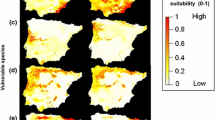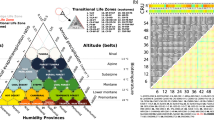Abstract
Lichens are widely utilized as indicators of air quality, forest health and climate change. In Central Europe, specific lichens have been designated as climate change indicators; however, the lichen biota of central Europe has been substantially altered by air pollution and only re-established during the past decades—complicating the interpretation of recent changes in lichen composition. To assess their validity as climate change indicators, we aggregated georeferenced records of these taxa and compared their historic and modern distributions. Modern distributions substantially differed for fewer than half of the indicator taxa with sufficient data to enable evaluation—reinforcing their utility as climate change indicators. However, modern distributions for approximately half of the taxa evaluated were largely confined to historically suitable climates—raising questions about their utility as climate change indicators. We were unable to model historic distributions for nearly two-thirds of all indicator taxa due to insufficient data. About one-third of these had multiple modern records but one or fewer historic records, suggesting they may indeed be expanding their range; however, about half had comparable or greater numbers of historic records relative to modern records, complicating their interpretation as climate change indicators. Together, our work illustrates that distributions for fewer than half of the lichen climate change indicators have substantially shifted in the recent past, and calls into question whether the remaining designated taxa are indeed strong positive indicators of climate change. We argue that more quantitative, evidence-based derivations of climate change indicators are required to accurately detect climate change.




Similar content being viewed by others
Data availability
Data are available at https://github.com/mpnelsen/Lichen_Climate_Change_Indicator_Europe
Code availability
Code is available at https://github.com/mpnelsen/Lichen_Climate_Change_Indicator_Europe
References
Aas W, Mortier A, Bowersox V et al (2019) Global and regional trends of atmospheric sulfur. Sci Rep 9:953. https://doi.org/10.1038/s41598-018-37304-0
Aptroot A, van Herk CM (2007) Further evidence of the effects of global warming on lichens, particularly those with Trentepohlia phycobionts. Environ Pollut 146:293–298. https://doi.org/10.1016/j.envpol.2006.03.018
Aptroot A, Stapper NJ, Košuthová A, Cáceres MES (2016) Lichens. In: Letcher TM (ed) Climate change, 2nd edn. Elsevier, Boston, pp 295–307
Bartholmess H, Erhardt W, Frahm JP, et al (2004) Biologische Messverfahren zur Ermittlung und Beurteilung der Wirkung von Luftverunreinigungen auf Flechten (Bioindikation). Kartierung der Diversität epiphytischer Flechten als Indikator für die Luftgüte VDI3957, Part 13. Verein Deutscher Ingenieure, Düsseldorf, Germany
Chamberlain S, Barve V, Mcglinn D, et al (2018) rgbif: Interface to the Global “Biodiversity” Information Facility API. Version 1.0.2. https://CRAN.R-project.org/package=rgbif
Conti ME, Cecchetti G (2001) Biological monitoring: lichens as bioindicators of air pollution assessment—a review. Environ Pollut 114:471–492. https://doi.org/10.1016/S0269-7491(00)00224-4
Elith J, Kearney M, Phillips S (2010) The art of modelling range-shifting species. Methods Ecol Evol 1:330–342. https://doi.org/10.1111/j.2041-210X.2010.00036.x
Ellenberg H (1974) Zeigerwerte der Gefäßpflanzen Mitteleuropas. Scripta Geobotanica 9:1–97
Ellenberg H (1979) Zeigerwerte der Gefäßpflanzen Mitteleuropas. 2. Aufl Scripta Geobotanica 9:1–122
Ellenberg H (1992) Zeigerwerte der Gefäßpflanzen (ohne Rubus). Scripta Geobotanica 18:9–166
Engler R, Guisan A, Rechsteiner L (2004) An improved approach for predicting the distribution of rare and endangered species from occurrence and pseudo-absence data. J Appl Ecol 41:263–274. https://doi.org/10.1111/j.0021-8901.2004.00881.x
Fielding AH, Bell JF (1997) A review of methods for the assessment of prediction errors in conservation presence/absence models. Environ Conserv 24:38–49. https://doi.org/10.1017/S0376892997000088
Fitzpatrick MC, Gotelli NJ, Ellison AM (2013) MaxEnt versus MaxLike: empirical comparisons with ant species distributions. Ecosphere 4:1–15. https://doi.org/10.1890/ES13-00066.1
Fowler D, Coyle M, Skiba U et al (2013) The global nitrogen cycle in the twenty-first century. Philos Trans R Soc B 368:20130164. https://doi.org/10.1098/rstb.2013.0164
Galloway JN, Aber JD, Erisman JW et al (2003) The nitrogen cascade. Bioscience 53:341–356. https://doi.org/10.1641/0006-3568(2003)053[0341:TNC]2.0.CO;2
Galloway JN, Dentener FJ, Capone DG et al (2004) Nitrogen cycles: past, present, and future. Biogeochemistry 70:153–226. https://doi.org/10.1007/s10533-004-0370-0
Grennfelt P, Hov Ø (2005) Regional air pollution at a turning point. Ambio 34:2–10. https://doi.org/10.1579/0044-7447-34.1.2
Hauck M (2009) Global warming and alternative causes of decline in arctic-alpine and boreal-montane lichens in North-Western Central Europe. Glob Change Biol 15:2653–2661. https://doi.org/10.1111/j.1365-2486.2009.01968.x
Hawksworth DL, McManus PM (1989) Lichen recolonization in London under conditions of rapidly falling sulphur dioxide levels, and the concept of zone skipping. Bot J Linn Soc 100:99–109. https://doi.org/10.1111/j.1095-8339.1989.tb01712.x
Hawksworth DL, Rose F (1970) Qualitative scale for estimating sulphur dioxide air pollution in England and Wales using epiphytic lichens. Nature 227:145–148. https://doi.org/10.1038/227145a0
Hawksworth DL, Rose F (1976) Lichens as pollution monitors. Edward Arnold, London, U.K.
Heberling JM, Prather LA, Tonsor SJ (2019) The changing uses of herbarium data in an era of global change: an overview using automated content analysis. Bioscience 69:812–822. https://doi.org/10.1093/biosci/biz094
Hijmans RJ, Cameron SE, Parra JL et al (2005) Very high resolution interpolated climate surfaces for global land areas. Int J Climatol 25:1965–1978. https://doi.org/10.1002/joc.1276
Hijmans RJ, Phillips SJ, Leathwick J, Elith J (2015) dismo: species distribution modeling. https://cran.r-project.org/web/packages/dismo/index.html
Hölzel N, Hickler T, Kutzbach L, et al (2016) Environmental impacts—terrestrial ecosystems. In: Quante M, Colijn F (eds) North Sea region climate change assessment. Springer International Publishing, Cham, pp 341–372
Insarov G, Schroeter B (2002) Lichen monitoring and climate change. In: Nimis PL, Scheidegger C, Wolseley PA (eds) Monitoring with lichens—monitoring lichens. Kluwer Academic Publishers, Dordrecht, pp 183–201
Jovan S, Riddell J, Padgett PE, Nash TH (2012) Eutrophic lichens respond to multiple forms of N: implications for critical levels and critical loads research. Ecol Appl 22:1910–1922. https://doi.org/10.1890/11-2075.1
Kanakidou M, Myriokefalitakis S, Daskalakis N et al (2016) Past, present, and future atmospheric nitrogen deposition. J Atmos Sci 73:2039–2047. https://doi.org/10.1175/JAS-D-15-0278.1
Kandler O, Poelt J (1984) Wiederbesiedlung der Innenstadt von München durch Flechten. Naturwissenschaftliche Rundschau 37:90–95
Kirschbaum U, Wirth V (2010) Flechten erkennen - Umwelt bewerten. Hessisches Landesamt für Umwelt und Geologie, Wiesbaden
Lang PLM, Willems FM, Scheepens JF et al (2019) Using herbaria to study global environmental change. New Phytol 221:110–122. https://doi.org/10.1111/nph.15401
LeBlanc SCF, Sloover JD (1970) Relation between industrialization and the distribution and growth of epiphytic lichens and mosses in Montreal. Can J Bot 48:1485–1496. https://doi.org/10.1139/b70-224
Nash TH, Gries C (1991) Lichens as indicators of air pollution. In: Gries C, Lipfert FW, Lippmann M, Nash TH (eds) Air pollution. Springer, Berlin, Heidelberg, pp 1–29
Nimis PL, Scheidegger C, Wolseley P (eds) (2002) Monitoring with lichens—monitoring lichens. Springer, Netherlands
Phillips SJ, Dudik M, Schapire RE (2018) Maxent software for modeling species niches and distributions (Version 3.4.1). https://biodiversityinformatics.amnh.org/open_source/maxent/
Poelt J (1969) Bestimmungsschlüssel europäischer Flechten. Verlag von J, Cramer, Lehre, Germany
Poelt J, Vězda A (1977) Bestimmungsschlüssel europäischer Flechten. Ergänzungsheft I. Bibliotheca Lichenologica 9:1–258
Poelt J, Vězda A (1981) Bestimmungsschlüssel europäischer Flechten. Ergänzungsheft II. Bibliotheca Lichenologica 26:1–390
R Core Team (2014) R: a language and environment for statistical computing. R Foundation for Statistical Computing, Vienna, Austria
Rose CI, Hawksworth DL (1981) Lichen recolonization in London’s cleaner air. Nature 289:289–292. https://doi.org/10.1038/289289a0
Sancho LG, Pintado A, Green TGA (2019) Antarctic studies show lichens to be excellent biomonitors of climate change. Diversity 11:42. https://doi.org/10.3390/d11030042
Schaap M, Banzhaf S, Scheuschner T et al (2017) Atmospheric nitrogen deposition to terrestrial ecosystems across Germany. Biogeosciences Discussions. https://doi.org/10.5194/bg-2017-491
Seaward MRD, Letrouit-Galinou MA (1991) Lichen recolonization of trees in the Jardin du Luxembourg, Paris. Lichenologist 23:181–186. https://doi.org/10.1017/S0024282991000324
Short AEZ, Dikow T, Moreau CS (2018) Entomological collections in the age of big data. Annu Rev Entomol 63:513–530. https://doi.org/10.1146/annurev-ento-031616-035536
Smith CW, Aptroot A, Coppins BJ et al (2009) The lichens of Great Britain and Ireland, 2nd edn. The British Lichen Society, London, U.K.
Søchting U (2004) Flavoparmelia caperata—a probable indicator of increased temperatures in Denmark. Graphis Scripta 15:53–56
Soltis PS, Nelson G, James SA (2018) Green digitization: online botanical collections data answering real-world questions. Appl Plant Sci 6:e1028. https://doi.org/10.1002/aps3.1028
Suarez AV, Tsutsui ND (2004) The value of museum collections for research and society. Bioscience 54:66–74. https://doi.org/10.1641/0006-3568(2004)054[0066:TVOMCF]2.0.CO;2
The Draft Directive (2017) Biologische Messverfahren zur Ermittlung und Beurteilung der Wirkung von Luftverunreinigungen (Biomonitoring) Kartierung von Flechten zur Ermittlung der Wirkung von lokalen Klimaveränderungen.
van Herk CM (1999) Mapping of ammonia pollution with epiphytic lichens in the Netherlands. Lichenologist 31:9–20. https://doi.org/10.1006/lich.1998.0138
van Herk CM (2009) Climate change and ammonia from cars as notable recent factors influencing epiphytic lichens in Zeeland, Netherlands. Bibliotheca Lichenologica 99:205–224
van Herk CM, Aptroot A, van Dobben HF (2002) Long-term monitoring in the Netherlands suggests that lichens respond to global warming. Lichenologist 34:141–154. https://doi.org/10.1006/lich.2002.0378
van Herk CM, Mathijssen-Spiekman EAM, deZwart D (2003) Long distance nitrogen air pollution effects on lichens in Europe. Lichenologist 35:347–359. https://doi.org/10.1016/S0024-2829(03)00036-7
Venables WN, Ripley BD (2002) Modern applied statistics with S, 4th edn. Springer-Verlag, New York
Vestreng V, Myhre G, Fagerli H et al (2007) Twenty-five years of continuous sulphur dioxide emission reduction in Europe. Atmos Chem Phys 7:3663–3681. https://doi.org/10.5194/acp-7-3663-2007
Warren DL, Glor RE, Turelli M (2010) ENMTools: a toolbox for comparative studies of environmental niche models. Ecography 33:607–611. https://doi.org/10.1111/j.1600-0587.2009.06142.x
Will-Wolf S, Geiser LH, Neitlich P, Reis AH (2006) Forest lichen communities and environment—how consistent are relationships across scales? J Veg Sci 17:171–184. https://doi.org/10.1111/j.1654-1103.2006.tb02436.x
Wirth V (1991) Zeigerwerte von Flechten. Scripta Geobotanica 18:215–237
Wirth V (2010) Ökologische Zeigerwerte von Flechten—Erweiterte und aktualisierte Fassung. Herzogia 23:229–248. https://doi.org/10.13158/heia.23.2.2010.229
Wirth V, Hauck M, Schultz M (2013) Die Flechten Deutschlands. Ulmer Verlag, Stuttgart, Germany
Yoshihito Ohmura, Mark R. D. Seaward, (2017) Is Glyphis cicatricosa an indicator for ‘global warming’ or an ‘urban heat island’ effect in Japan? Lichenologist 49(3):291–296. https://doi.org/10.1017/S0024282917000111
Acknowledgements
Andreas Beck and Robert Lücking are thanked for assistance with collections in M and B, respectively. We thank those involved in the review process for constructive feedback. All analyses were conducted at The Grainger Bioinformatics Center (Field Museum).
Funding
Negaunee Integrative Research Center (Field Museum), The Grainger Bioinformatics Center (Field Museum).
Author information
Authors and Affiliations
Contributions
HTL conceived the project, MPN and HTL gathered data, MPN analyzed data, MPN and HTL wrote the manuscript.
Corresponding authors
Ethics declarations
Conflict of interest
All the authors declare that they have no conflict of interest.
Additional information
Communicated by Pradeep Kumar Divakar.
Publisher's Note
Springer Nature remains neutral with regard to jurisdictional claims in published maps and institutional affiliations.
Electronic supplementary material
Below is the link to the electronic supplementary material.
Rights and permissions
About this article
Cite this article
Nelsen, M.P., Lumbsch, H.T. A data-driven evaluation of lichen climate change indicators in Central Europe. Biodivers Conserv 29, 3959–3971 (2020). https://doi.org/10.1007/s10531-020-02057-8
Received:
Revised:
Accepted:
Published:
Issue Date:
DOI: https://doi.org/10.1007/s10531-020-02057-8




